Cold Soba Noodles With Dipping Sauce (Zaru Soba)
Cool down this summer with zaru soba. The refreshing Japanese dish of cold soba noodles and flavourful dipping sauce is ready in 10 minutes – perfect for a quick and easy meal on a hot day.
This Japanese noodle dish of cold soba noodles with its umami-packed dipping sauce, known as zaru soba, is a refreshing and delicious summer meal.
It’s also a fun dining experience. Everyone gets to customise their noodle dipping sauce with grated daikon radish (or ginger), sliced green onions, toasted sesame seeds or wasabi before dipping the chilled noodles into the deeply flavoured tsuyu sauce.
This dish is popular during the hot summer months, but it’s a perfect meal for any time of year. Plus, it only takes 10 minutes to prepare! It’s the easiest way to explore the quintessential flavours of Japanese cuisine.
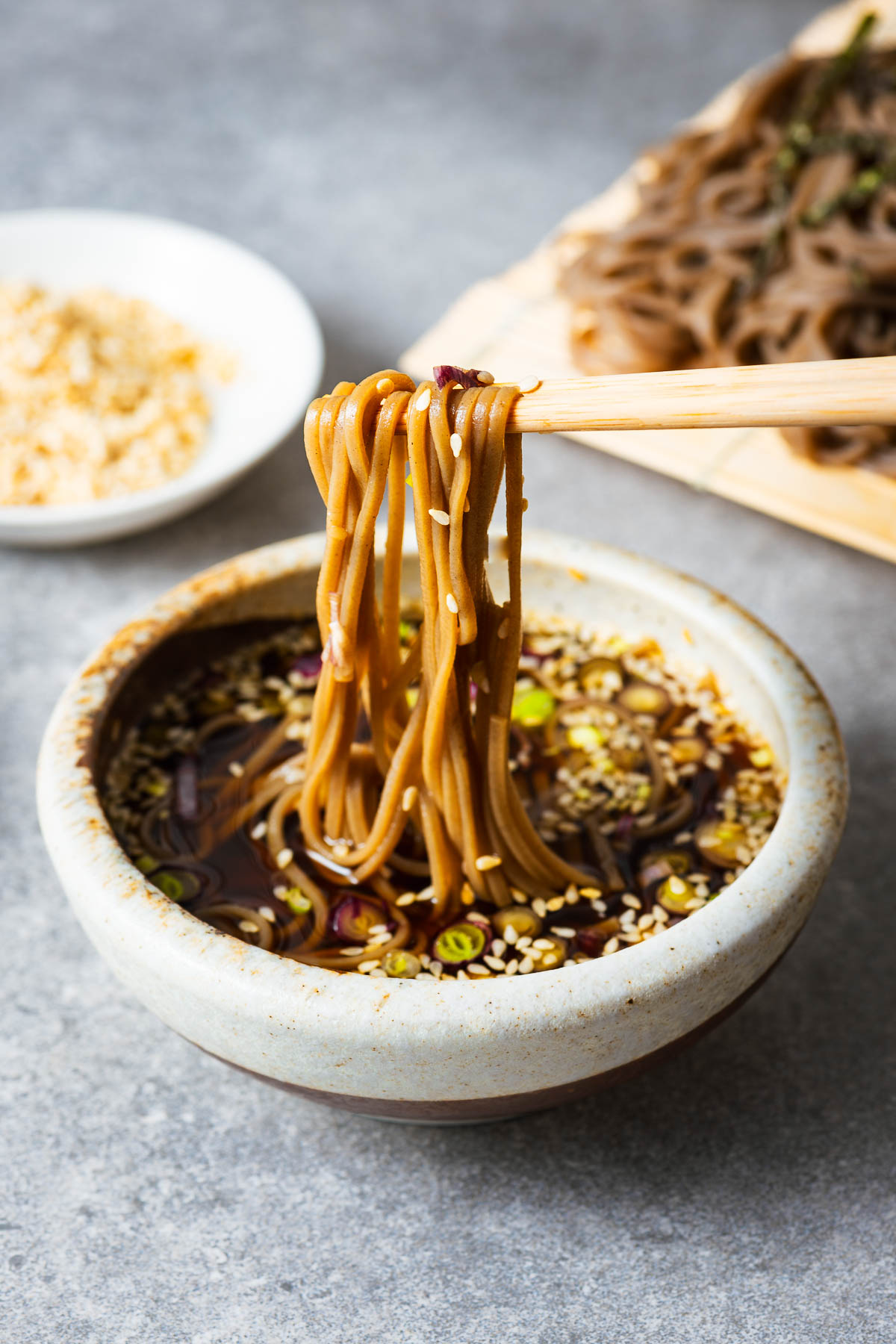
What is zaru soba?
Zaru soba is a popular Japanese dish featuring cold soba noodles (made from buckwheat flour) and a flavourful dipping sauce. The name comes from the bamboo basket the noodles are typically served in, known as a “zaru.”
To prepare the dish, boiled soba noodles get chilled in ice water. They are then drained and served in the bamboo basket, allowing excess water to drain.
Accompanying the noodles is a dipping sauce called “tsuyu”, made from a mixture of dashi (a type of Japanese soup stock), soy sauce, and mirin (a sweet rice wine). The sauce is deeply flavourful and complements the subtle taste of the soba.
The Japanese noodle dish is often garnished with thin strips of nori (seaweed) and served with sides like wasabi, green onions, and daikon radish to enhance the flavour.
Why dipping cold soba noodles in tsuyu is for you
Zaru soba is a refreshing and flavourful dish – perfect for hot summer days. And there are plenty of reasons to love this authentic Japanese recipe:
- Quick and easy: This dish takes only 10 minutes to prepare, making it a perfect option for busy weeknights or when you’re craving a quick and delicious meal.
- Versatile: Everyone gets to customise the dipping sauce to their liking with toppings like grated daikon, wasabi, green onions, or sesame seeds.
- Gluten-free option: Soba noodles are made from buckwheat flour, making this dish naturally gluten-free – use tamari instead of soy sauce for the dipping sauce.
- Perfect for hot weather: This dish is traditionally served chilled, making it a great option for those hot summer days when you don’t want to cook!
- Authentic Japanese flavours: This recipe uses traditional Japanese ingredients like dashi stock, soy sauce, mirin, and nori seaweed to create a flavourful and authentic Japanese home cooked meal.
Zaru soba is the easiest recipe to explore the umami-packed flavours of Japanese cuisine.
Ingredients and substitutes
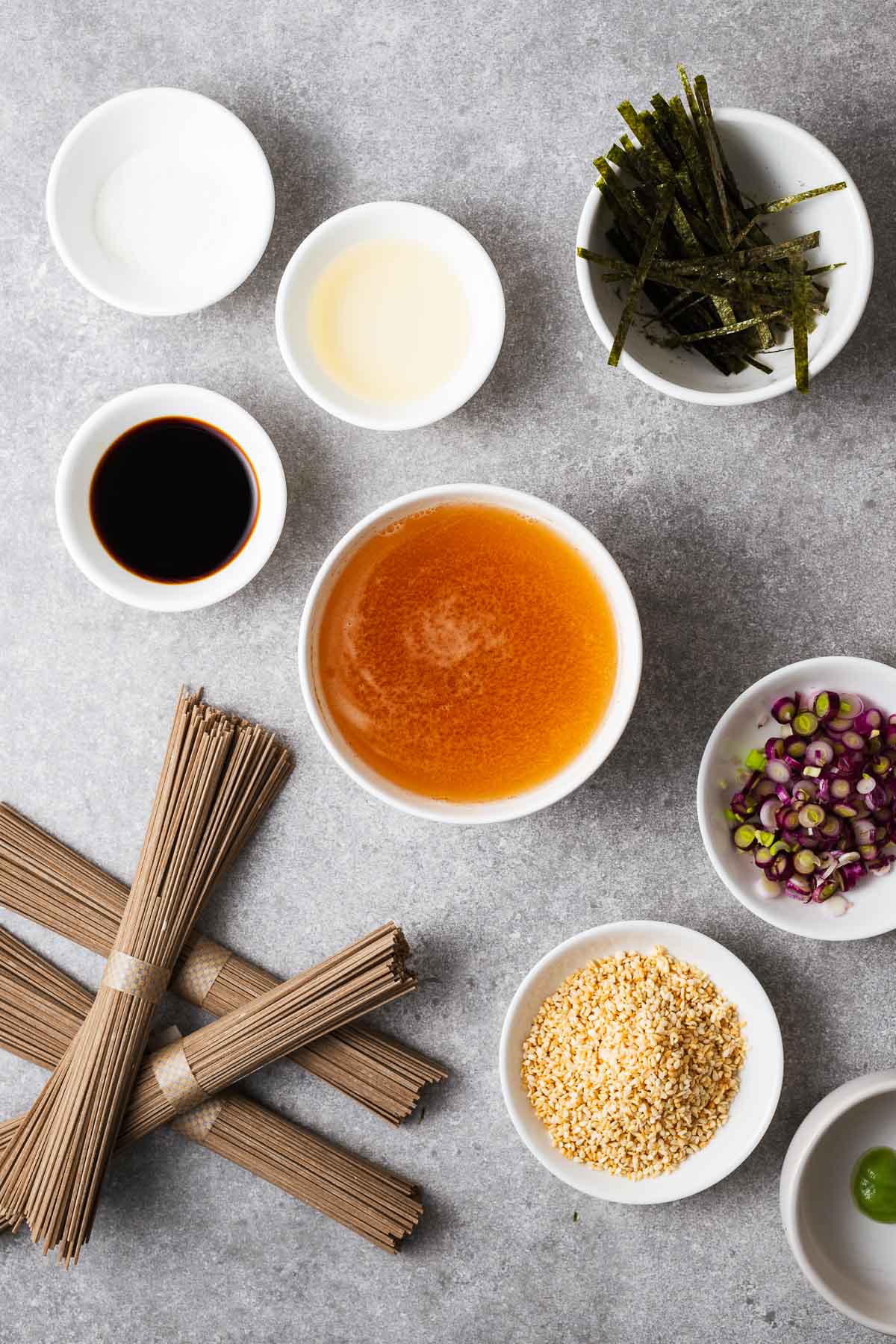
This super simple Japanese recipe requires only a few simple ingredients:
- Dried soba noodles: Soba noodles are made from buckwheat flour and have a nutty flavour. You can find them in the Asian section of your grocery store, or at an Asian market. If you can’t find soba noodles, you can also try somen noodles.
- Shredded nori: Take a sheet of nori seaweed and finely cut it into strips. Use it as a garnish for your cooked and chilled soba noodles.
- Dashi stock: Dashi stock is a Japanese broth. I use awase dashi, made from katsuobushi (dried bonito flakes) and kombu (dried kelp). You can make awase dashi at home, or use hon dashi powder (instant dashi powder). You can also use a kombu shiitake dashi if you want a vegan dipping sauce.
- Soy sauce: While Japanese shoyu is the ideal choice for Japanese recipes, you can use any light soy sauce or all-purpose soy sauce for the tsuyu dipping sauce. You can also use tamari or coconut aminos for a gluten-free option.
- Mirin: Mirin is a sweet rice wine used in Japanese cooking. It adds a touch of sweetness to the dipping sauce. If you don’t have mirin, you can use sake or sherry with a pinch of sugar.
- Sugar: This is an optional ingredient, but it helps to balance the flavours in the dipping sauce. You can use white or brown sugar or any other sweetener you prefer. Taste the dipping sauce before you add the sugar.
You can also use store-bought or homemade mentsuyu concentrate for the dipping sauce. Simply mix ⅓ cup of chilled mentsuyu concentrate with ⅔ cup of ice-cold water for 1 cup of dipping sauce. Taste and add a teaspoon of sugar to sweeten, or more to taste.
It’s easy to make concentrated mentsuyu from scratch using kombu (dried kelp), katsuobushi (dried bonito flakes), sake, mirin and soy sauce. See the mentsuyu recipe for more (including instructions for a vegan version with dried shiitake mushrooms)
Optional dipping sauce additions
One of the fun interactive aspects of eating zaru soba is that everyone gets to customise their tsuyu dipping sauce at the table. I often skip the toppings when I’m after convenience – the dipping sauce is already utterly delicious.
But you can serve the chilled soba noodles and dipping sauce with small plates with toppings:
- finely grated daikon (or ginger),
- toasted sesame seeds,
- thinly sliced green onions (scallions or spring onions), or
- wasabi for some heat.
Learn how to toast sesame seeds.
How to make cold soba noodles with dipping sauce
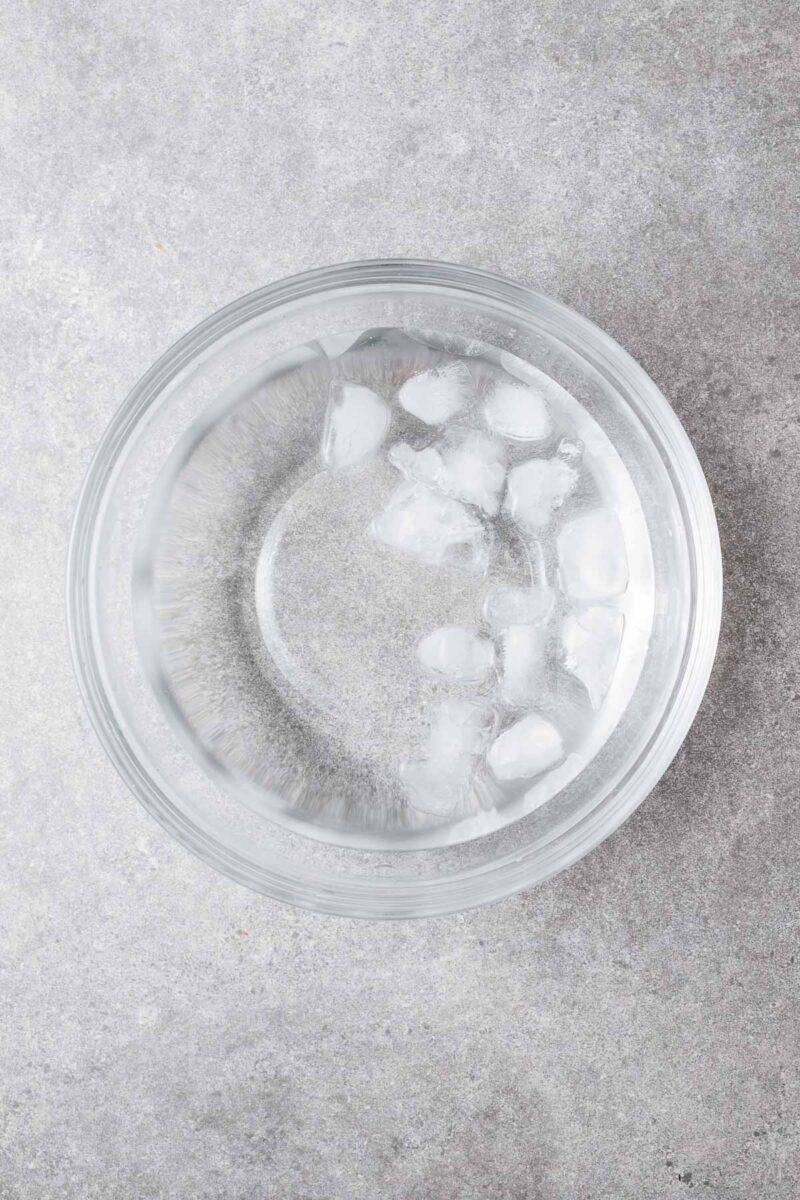
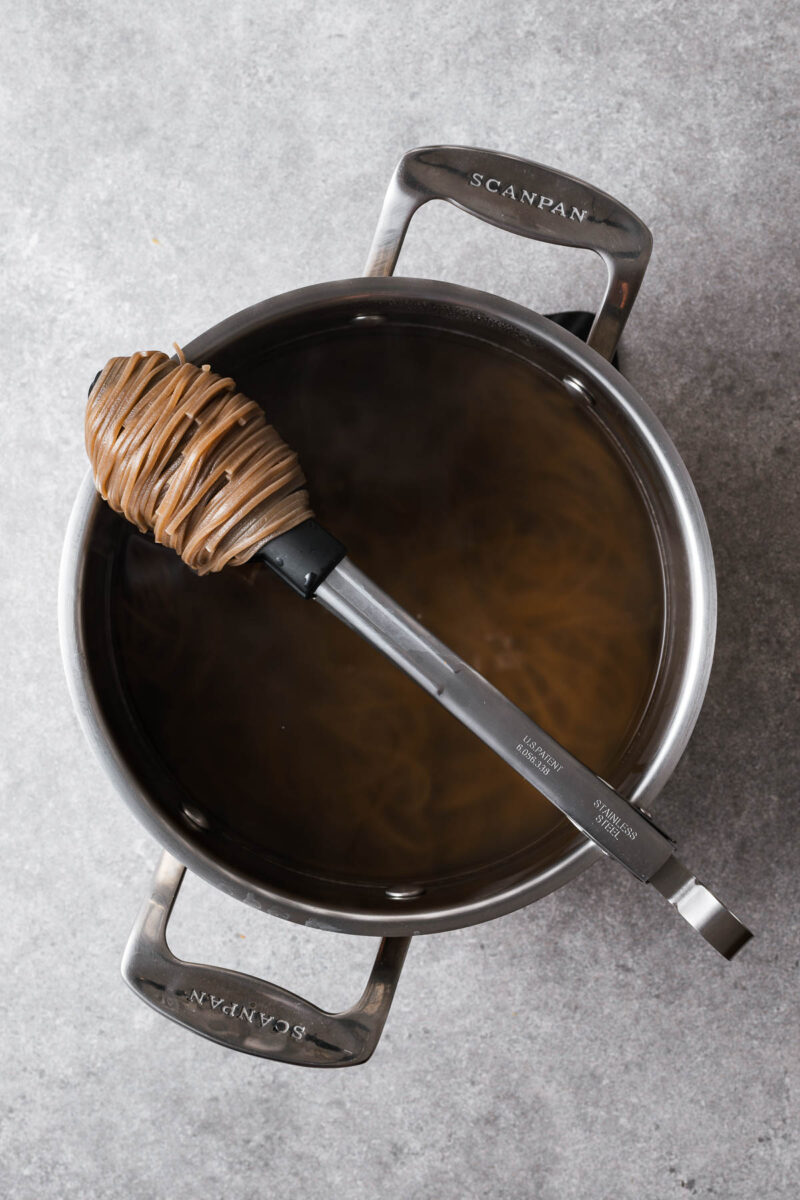
Step 1: Prepare an ice bath by adding cold water and a handful of ice cubes to a large bowl. Dropping the cooked noodles in ice water stops the cooking process and creates perfectly chewy cold soba noodles.
Step 2: Cook the soba noodles. In a large pot, bring at least 6 cups of water to a boil over high heat. Add the soba noodles and cook according to the package instructions, about 5 minutes. Be sure to stir occasionally to prevent sticking.
Reserve some of the soba noodle cooking water (known as sobayu). When you finish your bowl of soba noodles, top your dipping sauce bowl up with some sobayu and sip it up as a brothy soup.
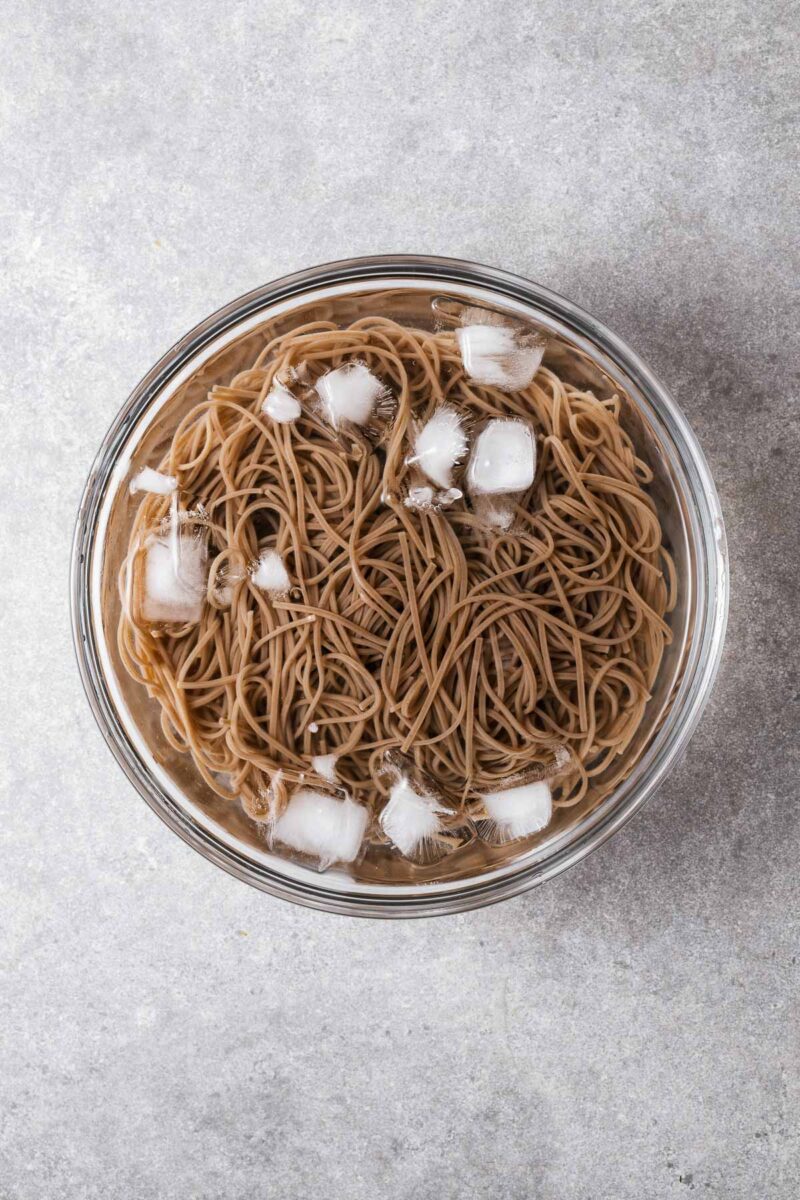
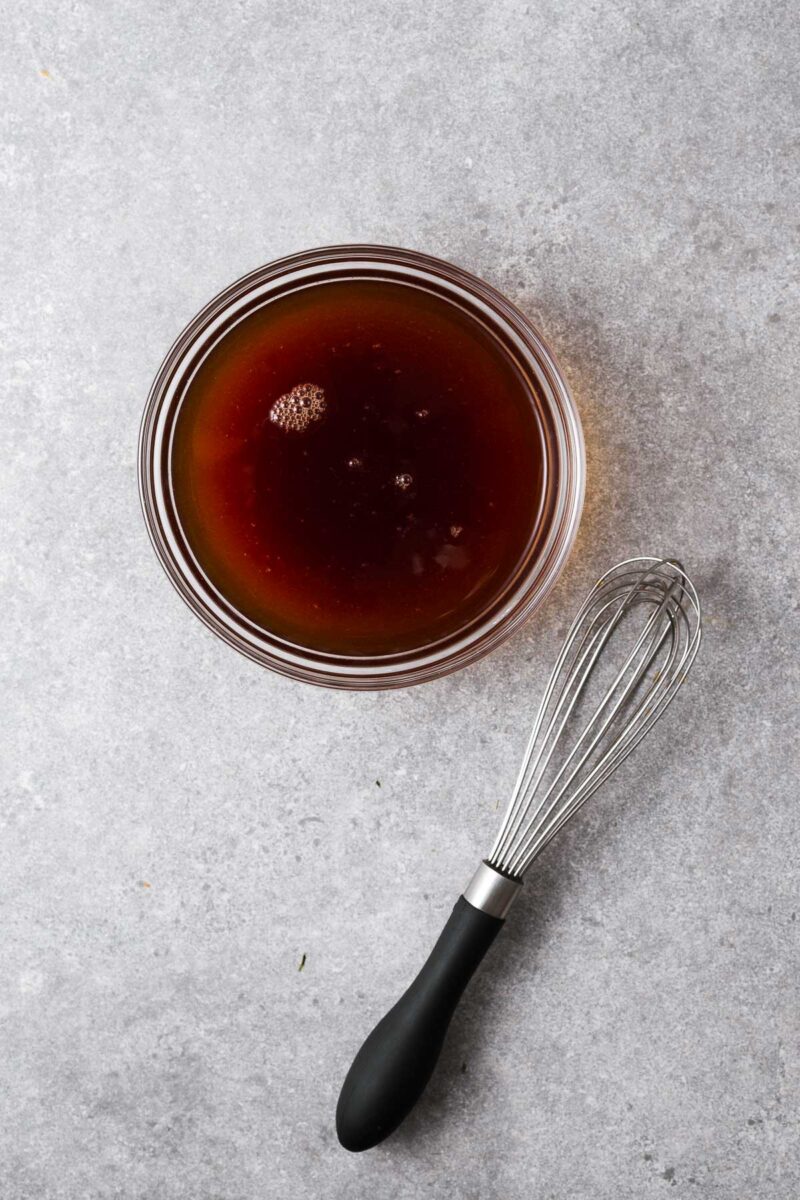
Step 3: Drain and rinse the cooked noodles under cold running water to remove excess starch and prevent them from sticking together. Then place them in the ice bath for 30 seconds to cool down. Drain well (excess water can cause soggy noodles) and set aside.
Step 4: Make the soba noodle dipping sauce. In a small bowl, mix together ⅔ cup of chilled dashi stock, 2 tablespoons of soy sauce, 2 tablespoons of mirin, and 1 teaspoon of sugar (optional). Adjust the sauce to your liking by adding more cold water for a milder flavour, hon dashi powder for more umami, soy sauce for more saltiness, or mirin for more sweetness.
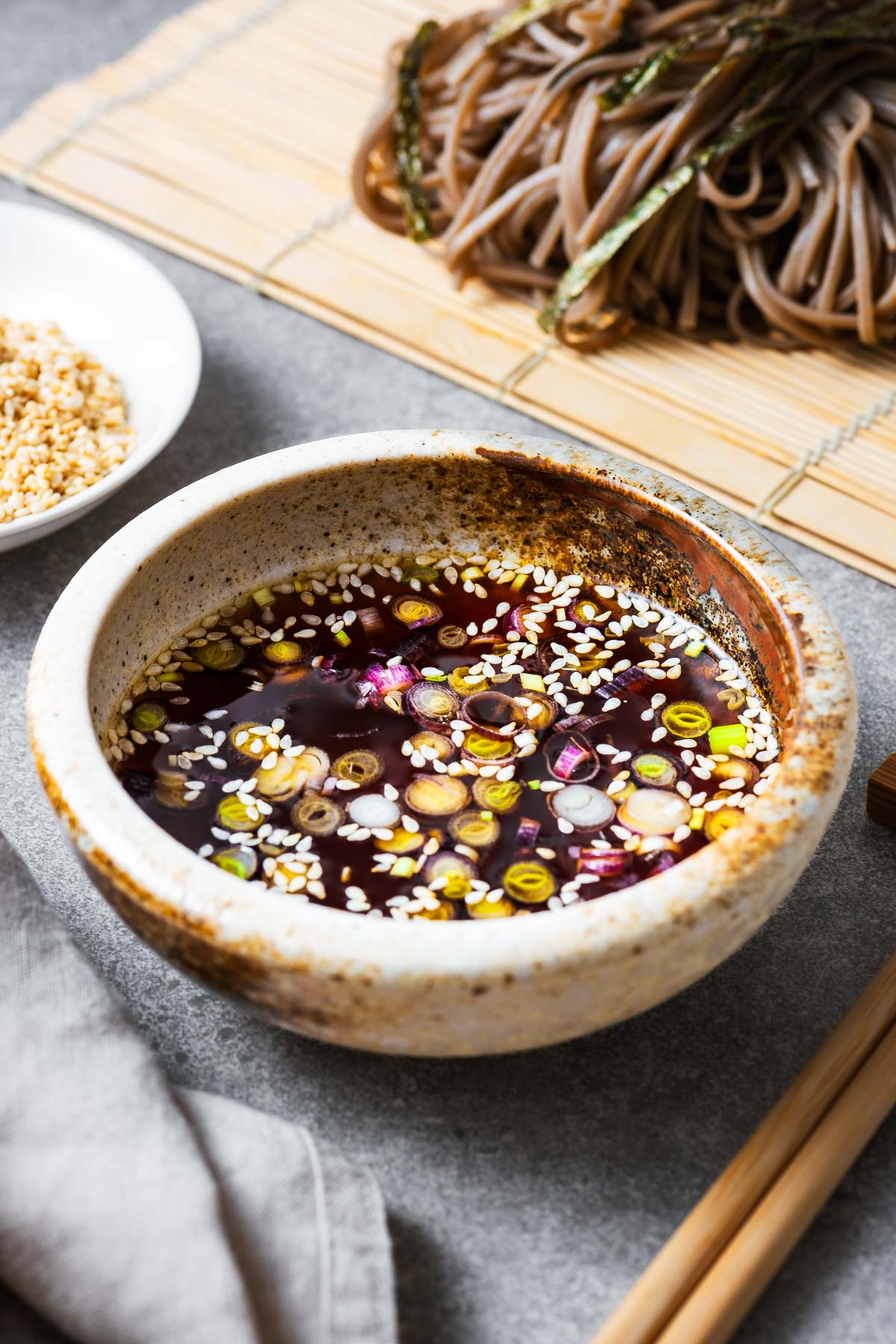
Step 5: To serve, divide the soba noodles into individual bowls or a zaru (shallow bamboo basket) to prevent them from getting soggy. Garnish with shredded nori seaweed. Serve the dipping sauce in small bowls, one for each person.
Serve optional toppings like grated daikon, wasabi, sliced green onions, and toasted sesame seeds in small bowls for everyone to customise their dipping sauce.
How to eat cold soba noodles
To serve cold zaru soba, place the cooked and chilled noodles on a zaru or bamboo place mat. This helps to drain off excess water, but you can also serve the soba noodles in individual bowls.
Give each person a bowl with noodle dipping sauce. And arrange optional ingredients like freshly grated daikon, wasabi, sliced green onions, or toasted sesame seeds in small bowls to be shared.
To eat, simply dip the chilled soba noodles into the soba dipping sauce and enjoy the authentic flavours of Japanese cuisine.
You can serve zaru soba with stir-fried vegetables or Japanese vegetable tempura to bulk up the meal.
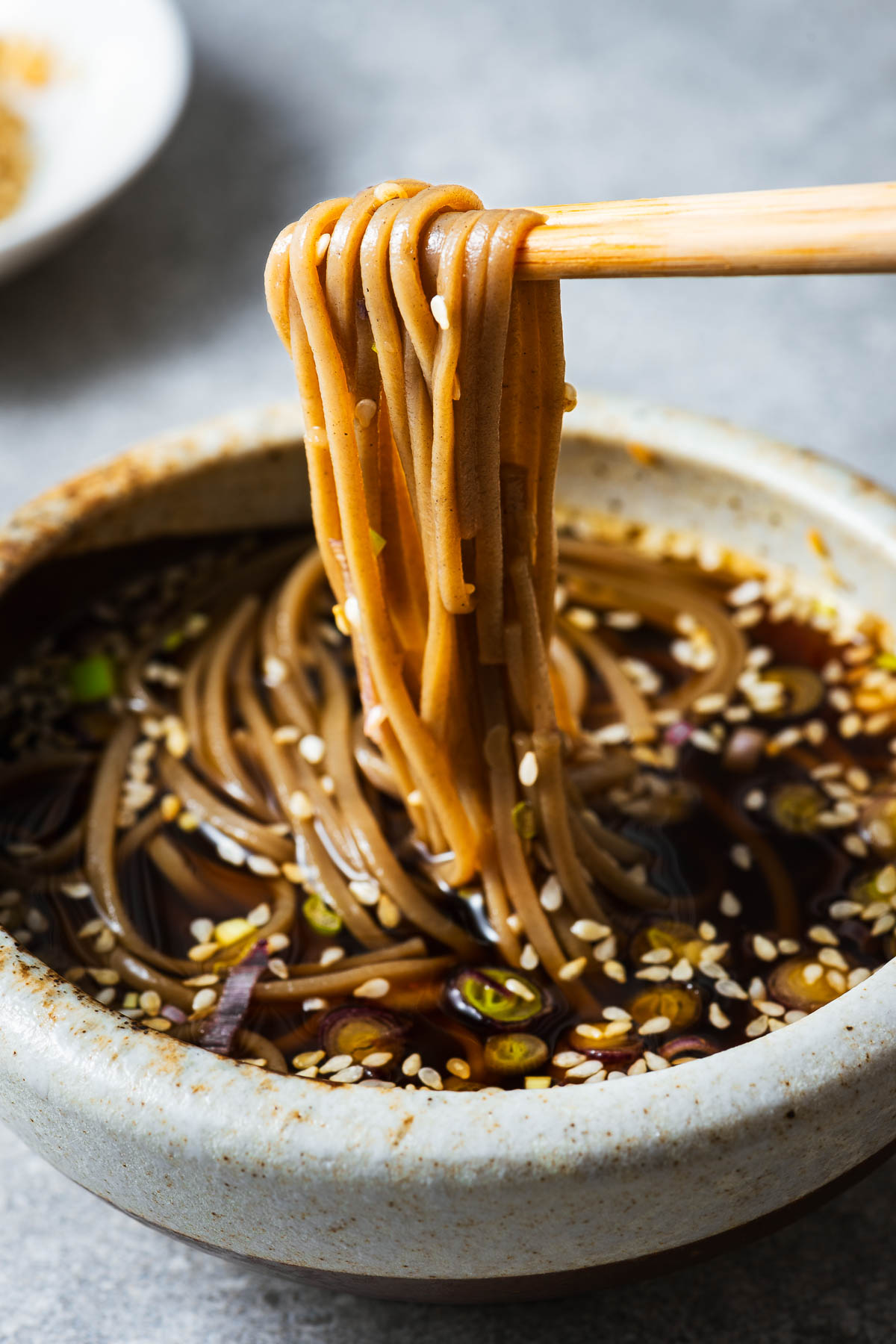
Frequently asked questions
Soba dipping sauce is a traditional Japanese sauce made with a base of soy sauce, dashi (fish and seaweed stock), mirin (sweet rice wine), and sugar. Other variations may include ingredients like rice vinegar, ginger, and green onions for added flavour.
Cold soba noodles can be enjoyed on their own or paired with a variety of toppings and side dishes. Popular accompaniments include sliced green onions, grated daikon, wasabi, tempura, and tsuyu dipping sauce. It can also be served with a side of cold tofu, Japanese vegetable tempura or a simple salad.
Soba noodles can be served both hot and cold. Cold soba noodle dishes like zaru soba are typically served in the summer months as a refreshing and light meal. However, soba noodles can also be served hot in soups or stir-fries during colder weather.
Cold soba sauce has a unique flavour that is both savoury and slightly sweet. It also has a hint of umami from the dashi stock. The overall taste is well-balanced and complements the nutty flavour of the soba noodles.

Ingredients
- 7 oz soba noodles (buckwheat noodles)
- 6 cups of water , for cooking noodles
- ice cubes and water , for the ice bath
- a handful of shredded nori , for garnish
Soba dipping sauce (see notes for mentsuyu concentrate dipping sauce)
- ⅔ cup chilled dashi stock , homemade dashi or from dashi powder*
- 3 tablespoons soy sauce
- 3 tablespoons mirin
- 1 teaspoon sugar (optional)
Dipping sauce toppings (optional):
- finely grated daikon or daikon
- wasabi
- sliced green onions (scallions)
- toasted sesame seeds
Instructions
- Ready an ice bath by adding cold water and a handful of ice cubes to a large bowl.
- Bring a large amount of water to a boil – at least 6 cups. Add the soba noodles and cook according to packet instructions or until just tender – about 5 minutes for me. Don’t overcook the noodles, they need to be firm and chewy. And stir now and then to avoid sticking.
- Drain and rinse the cooked noodles under cold running water to remove excess starch and avoid sticking. Then place them in the ice bath for 30 seconds, drain well and set aside.
- While the noodles are cooking, mix the dashi stock, soy sauce and mirin in a small bowl. It should be sweet and savoury with punchy flavours. Add sugar if you prefer the sauce a bit sweeter. Taste again and adjust with more cold water (less intense), hon dashi powder (more umami), soy sauce (saltier), or mirin (sweeter) to suit your taste.
- To serve, divide the soba noodles into individual bowls or zaru* and garnish with the shredded nori seaweed. Serve the dipping sauce in small bowls – one for each person to dip their noodles in. Place the optional dipping sauce toppings on small plates to share. Then every person should customise their dipping sauce with some wasabi, grated ginger/daikon, sliced green onions or toasted sesame seeds. Use chopsticks to pick up some noodles, dip them into your customised dipping sauce and enjoy your zaru soba!
Notes
- Dashi stock: You can use homemade dashi stock. Or dissolve 1 teaspoon of hon dashi in ⅔ cup of ice cold water – or mix according to package instructions. If you enjoy an icy cold dipping sauce, as I do, place your dashi in the freezer for 10 minutes before serving.
- Dipping sauce from mentsuyu: You can also make the dipping sauce from store-bought or homemade mentsuyu concentrate. For one cup of mentsuyu noodle dipping sauce, mix a ⅓ cup of chilled mentsuyu concentrate with ⅔ cup ice-cold water. I often make a big batch of mentsuyu since it keeps for 4 weeks in the fridge. And it’s super easy to make from scratch using katsuobushi (dried bonito flakes), kombu (dried kelp), soy sauce, sake and mirin.
- A zaru is a shallow bamboo basket used to serve cold noodles in Japanese cuisine. It helps to avoid soggy noodles. But you can simply drain the noodles well and serve them in bowls. Or line a normal dinner plate with a bamboo mat.

These soba noodles were absolutely crave-worthy! I’m going to be making them over and over again, I already know.
I’m so glad you liked them, Paula! This is one of my go-to quick dinners in peak summer.